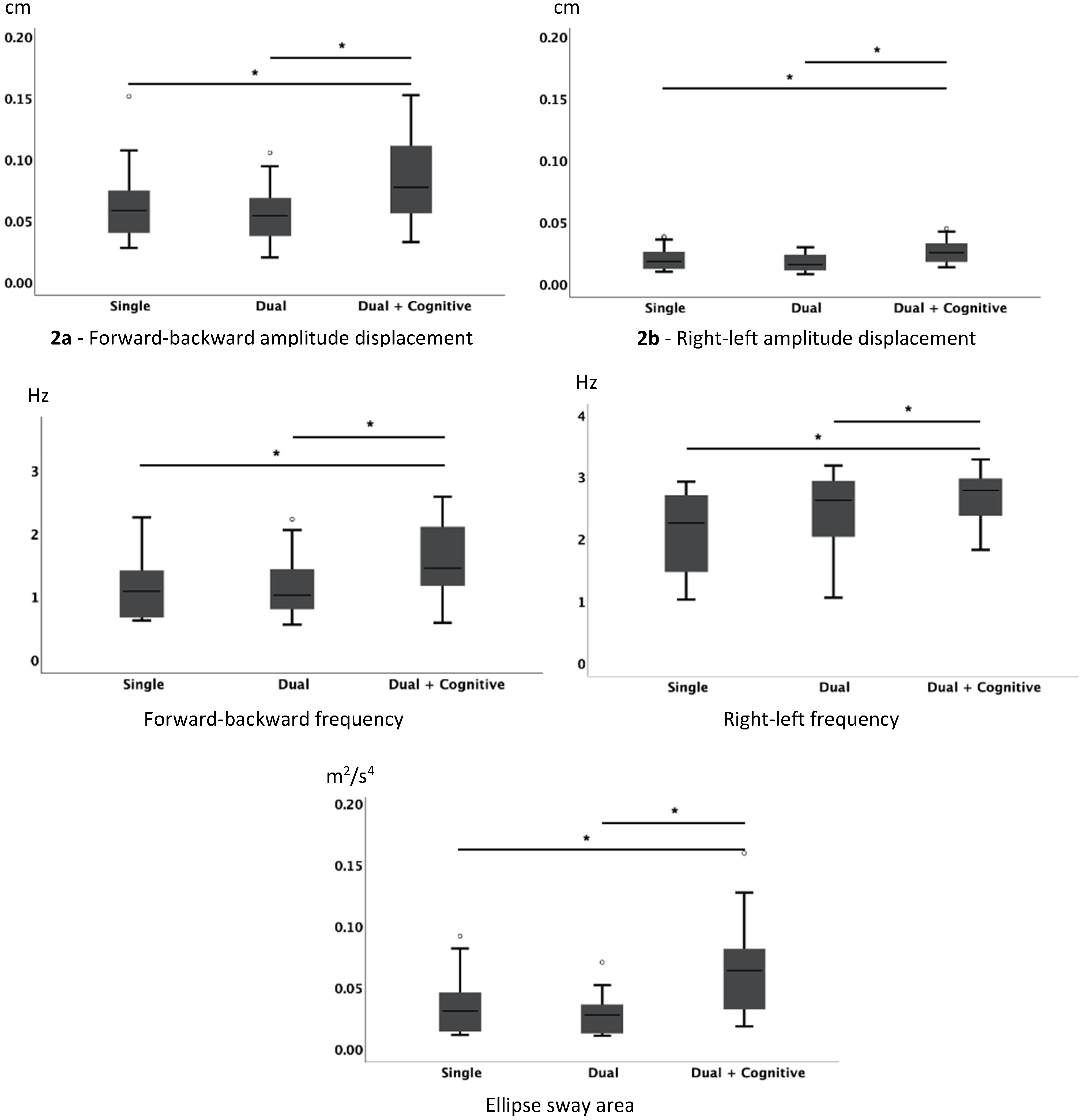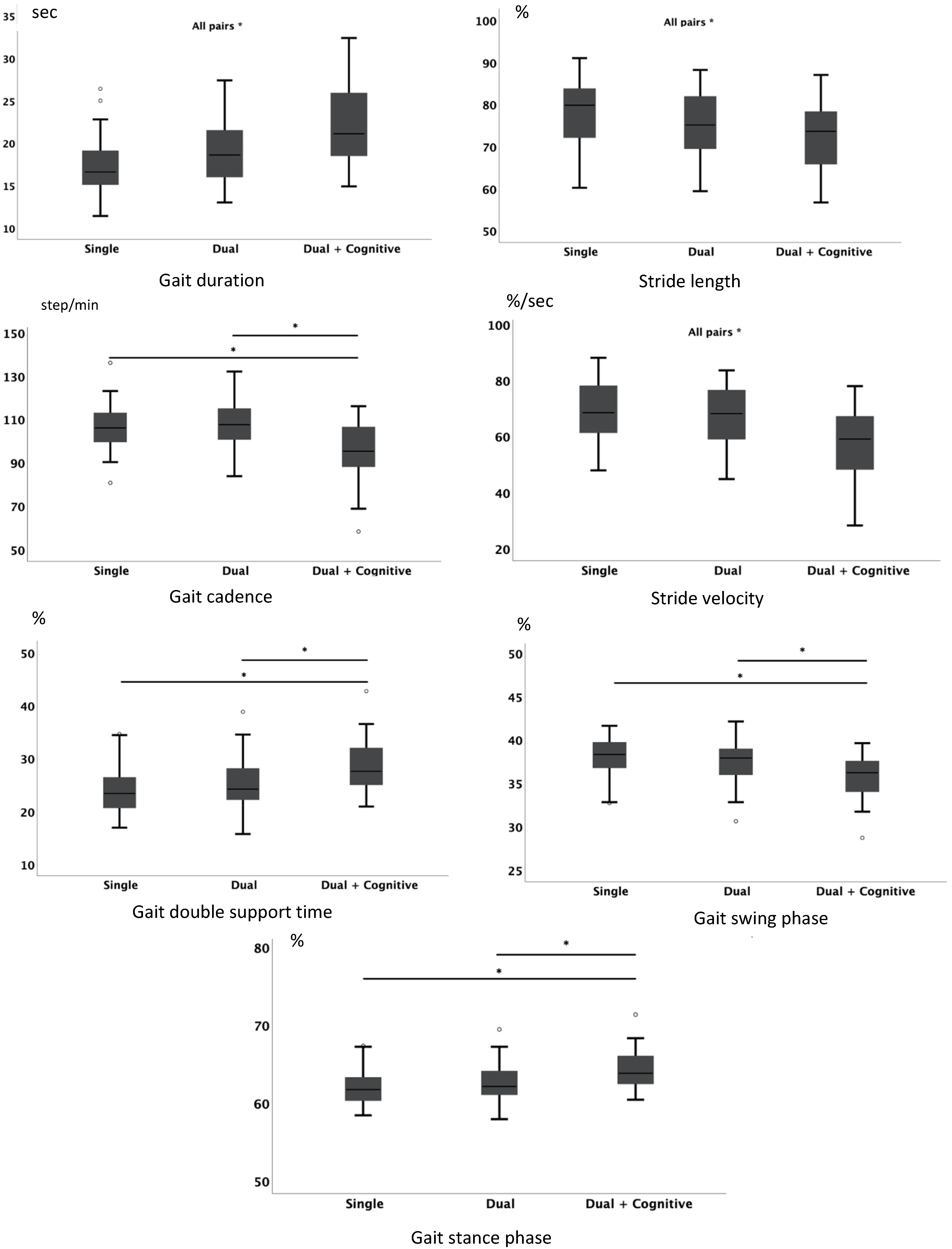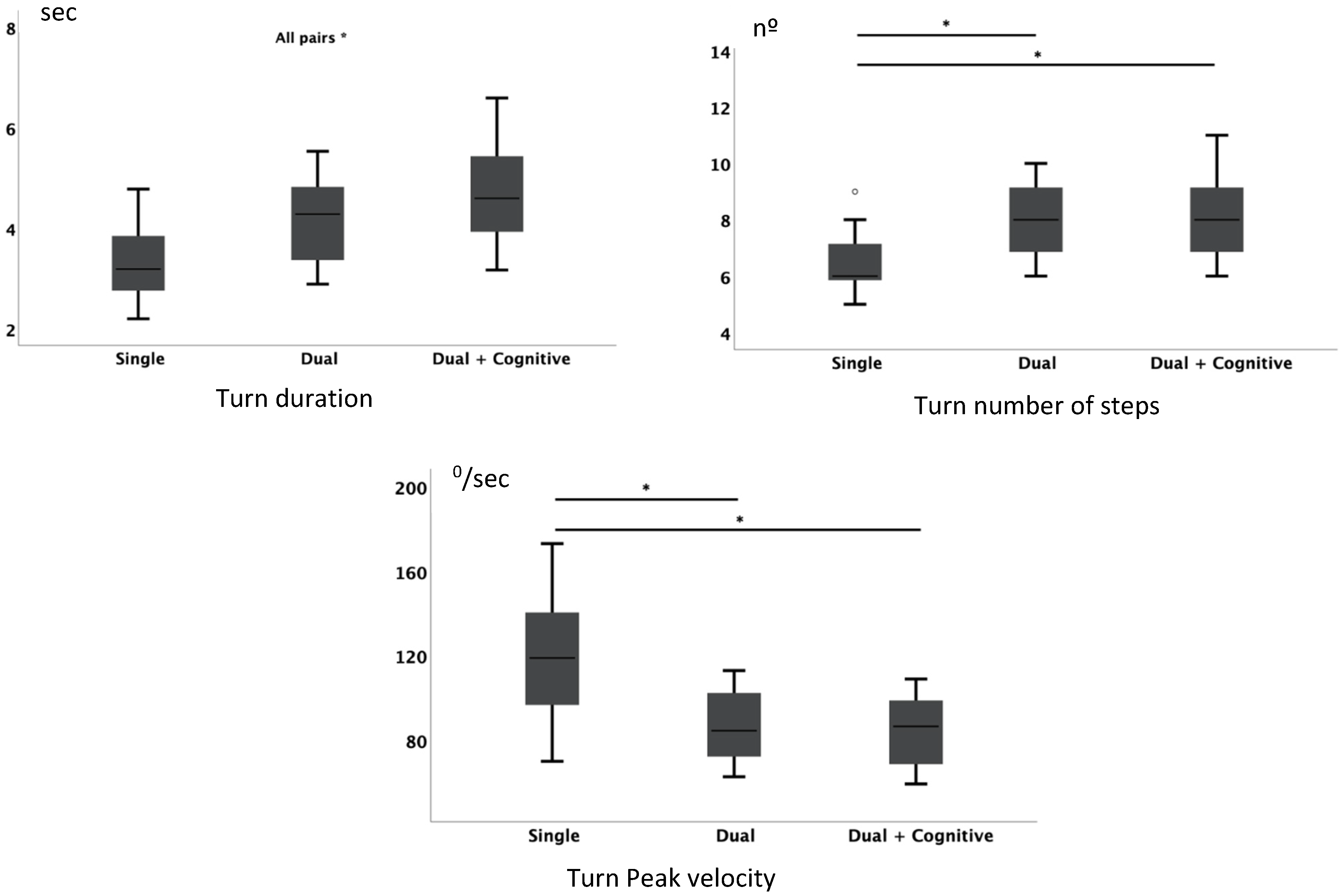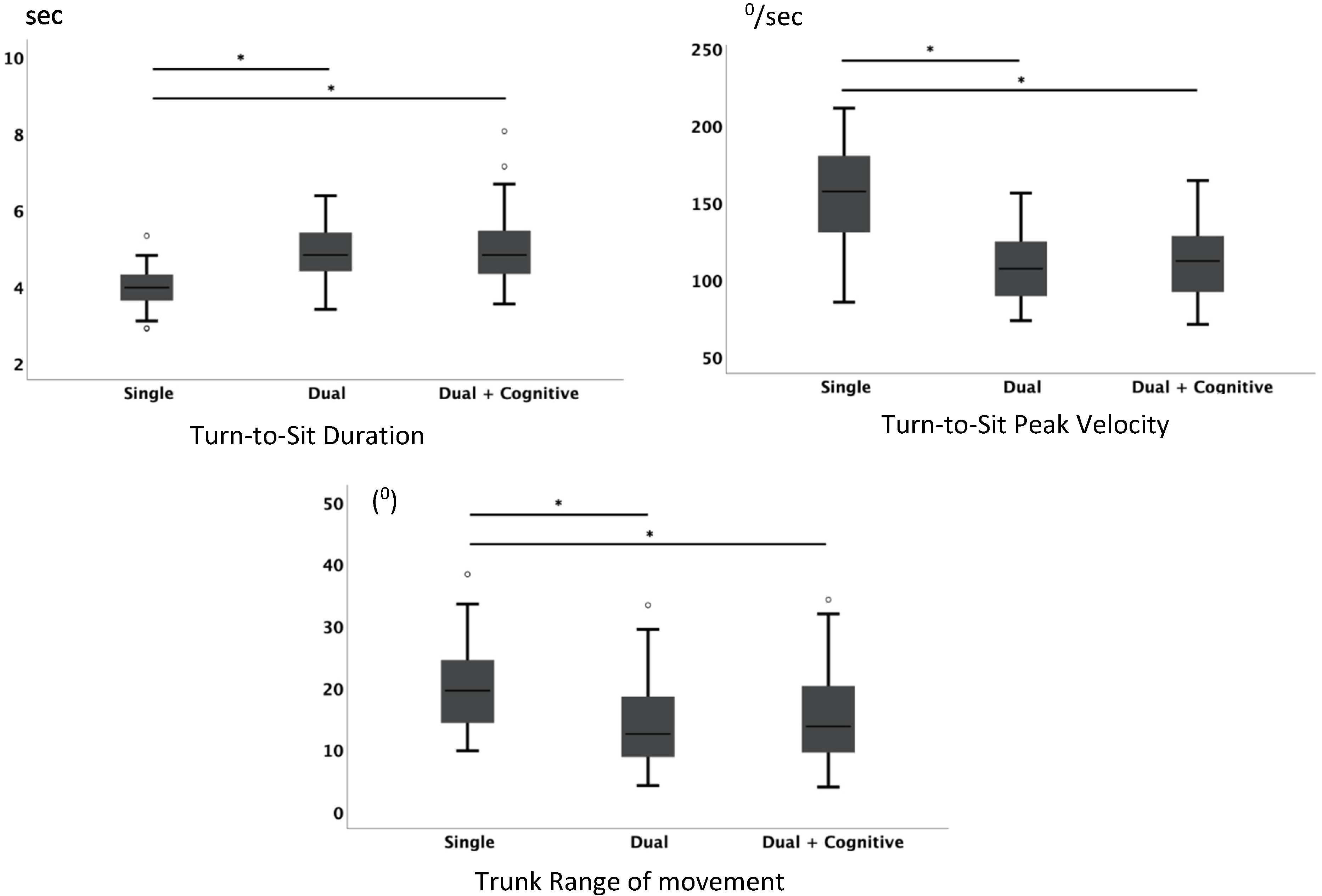The Effects of Different Types of Dual Tasking on Balance in Healthy Older Adults
Abstract
1. Introduction
2. Materials and Methods
2.1. Study Design
2.2. Sampling and Recruitment
2.3. Ethics and Procedures
2.4. Data Collection
2.5. Data Analysis
3. Results
3.1. ISWAY Test
3.2. ITUG Test
3.2.1. Sit-to-Stand Phase
3.2.2. Gait Phase
3.2.3. Turning Phase
3.2.4. Turn-to-Sit Phase
4. Discussion
5. Conclusions
Author Contributions
Funding
Institutional Review Board Statement
Informed Consent Statement
Data Availability Statement
Acknowledgments
Conflicts of Interest
References
- Raichlen, D.A.; Bharadwaj, P.K.; Nguyen, L.A.; Franchetti, M.K.; Zigman, E.K.; Solorio, A.R.; Alexander, G.E. Effects of simultaneous cognitive and aerobic exercise training on dual-task walking performance in healthy older adults: Results from a pilot randomized controlled trial. BMC Geriatr. 2020, 20, 83. [Google Scholar] [CrossRef]
- Agmon, M.; Kodesh, E.; Kizony, R. The effect of different types of walking on dual-task performance and task prioritization among community-dwelling older adults. Sci. World J. 2014, 2014, 259547. [Google Scholar] [CrossRef]
- Ruffieux, J.; Keller, M.; Lauber, B.; Taube, W. Changes in Standing and Walking Performance under Dual-Task Conditions across the Lifespan. Sports Med. 2015, 45, 1739–1758. [Google Scholar] [CrossRef]
- Liu-Ambrose, T.; Katarynych, L.A.; Ashe, M.C.; Nagamatsu, L.S.; Hsu, C.L. Dual-task gait performance among community-dwelling senior women: The role of balance confidence and executive functions. J. Gerontol. Series A Biol. Sci. Med. Sci. 2009, 64, 975–982. [Google Scholar] [CrossRef] [PubMed]
- Muci, B.; Keser, I.; Meric, A.; Karatas, G.K. What are the factors affecting dual-task gait performance in people after stroke? Physiother. Theory Pract. 2020, 16, 1–8. [Google Scholar] [CrossRef] [PubMed]
- Ghai, S.; Ghai, I.; Effenberg, A.O. Effects of dual tasks and dual-task training on postural stability: A systematic review and meta-analysis. Clin. Interv. Aging 2017, 12, 557–577. [Google Scholar] [CrossRef] [PubMed]
- Hunter, S.W.; Omana, H.; Madou, E.; Wittich, W.; Hill, K.D.; Johnson, A.M.; Divine, A.; Holmes, J.D. Effect of dual-tasking on walking and cognitive demands in adults with Alzheimer’s dementia experienced in using a 4-wheeled walker. Gait Posture 2020, 77, 164–170. [Google Scholar] [CrossRef]
- Mancini, M.; Schlueter, H.; El-Gohary, M.; Mattek, N.; Duncan, C.; Kaye, J.; Horak, F.B. Continuous Monitoring of Turning Mobility and Its Association to Falls and Cognitive Function: A Pilot Study. J. Gerontol. 2016, 71, 1102–1108. [Google Scholar] [CrossRef]
- Fraser, S.A.; Dupuy, O.; Pouliot, P.; Lesage, F.; Bherer, L. Comparable Cerebral Oxygenation Patterns in Younger and Older Adults during Dual-Task Walking with Increasing Load. Front. Aging Neurosci. 2016, 8, 240. [Google Scholar] [CrossRef]
- Richer, N.; Lajoie, Y. Automaticity of Postural Control while Dual-tasking Revealed in Young and Older Adults. Exp. Aging Res. 2020, 46, 1–21. [Google Scholar] [CrossRef]
- Hillel, I.; Gazit, E.; Nieuwboer, A.; Avanzino, L.; Rochester, L.; Cereatti, A.; Croce, U.D.; Rikkert, M.O.; Bloem, B.R.; Pelosin, E.; et al. Is every-day walking in older adults more analogous to dual-task walking or to usual walking? Elucidating the gaps between gait performance in the lab and during 24/7 monitoring. Eur. Rev. Aging Phys. Act. 2019, 16, 6. [Google Scholar] [CrossRef] [PubMed]
- Smith, E.; Cusack, T.; Blake, C. The effect of a dual task on gait speed in community dwelling older adults: A systematic review and meta-analysis. Gait Posture 2016, 44, 250–258. [Google Scholar] [CrossRef] [PubMed]
- Hemmati, L.; Rojhani-Shirazi, Z.; Malek-Hoseini, H.; Mobaraki, I. Evaluation of Static and Dynamic Balance Tests in Single and Dual Task Conditions in Participants with Nonspecific Chronic Low Back Pain. J. Chiropr. Med. 2017, 16, 189–194. [Google Scholar] [CrossRef] [PubMed]
- Mancini, M.; King, L.; Salarian, A.; Holmstrom, L.; McNames, J.; Horak, F.B. Mobility Lab to Assess Balance and Gait with Synchronized Body-worn Sensors. J. Bioeng. Biomed. Sci. 2011, 7 (Suppl. S1). [Google Scholar] [CrossRef]
- Salarian, A.; Horak, F.B.; Zampieri, C.; Carlson-Kuhta, P.; Nutt, J.G.; Aminian, K. iTUG, a sensitive and reliable measure of mobility. IEEE Trans. Neural Syst. Rehabil. Eng. 2010, 18, 303–310. [Google Scholar] [CrossRef]
- Falbo, S.; Condello, G.; Capranica, L.; Forte, R.; Pesce, C. Effects of Physical-Cognitive Dual Task Training on Executive Function and Gait Performance in Older Adults: A Randomized Controlled Trial. BioMed Res. Int. 2016, 2016, 5812092. [Google Scholar] [CrossRef]
- Azadian, E.; Torbati, H.R.; Kakhki, A.R.; Farahpour, N. The effect of dual task and executive training on pattern of gait in older adults with balance impairment: A Randomized controlled trial. Arch. Gerontol. Geriatr. 2016, 62, 83–89. [Google Scholar] [CrossRef]
- Ries, J.D. Rehabilitation for Individuals with Dementia: Facilitating Success. Curr. Geriatr. Rep. 2018, 7, 59–70. [Google Scholar] [CrossRef]
- Åhman, H.B.; Cedervall, Y.; Kilander, L.; Giedraitis, V.; Berglund, L.; McKee, K.J.; Rosendahl, E.; Ingelsson, M.; Åberg, A.C. Dual-task tests discriminate between dementia, mild cognitive impairment, subjective cognitive impairment, and healthy controls—A cross-sectional cohort study. BMC Geriatr. 2020, 20, 258. [Google Scholar] [CrossRef]
- Montero-Odasso, M.M.; Sarquis-Adamson, Y.; Speechley, M.; Borrie, M.J.; Hachinski, V.C.; Wells, J.; Riccio, P.M.; Schapira, M.; Sejdic, E.; Camicioli, R.M.; et al. Association of Dual-Task Gait With Incident Dementia in Mild Cognitive Impairment: Results From the Gait and Brain Study. JAMA Neurol. 2017, 74, 857–865. [Google Scholar] [CrossRef] [PubMed]
- Li, F.; Harmer, P. Prevalence of Falls, Physical Performance, and Dual-Task Cost While Walking in Older Adults at High Risk of Falling with and Without Cognitive Impairment. Clin. Interv. Aging 2020, 15, 945–952. [Google Scholar] [CrossRef]
- Tomas-Carus, P.; Biehl-Printes, C.; Pereira, C.; Veiga, G.; Costa, A.; Collado-Mateo, D. Dual task performance and history of falls in community-dwelling older adults. Exp. Gerontol. 2019, 120, 35–39. [Google Scholar] [CrossRef] [PubMed]
- Jung, H.W.; Jang, I.Y.; Lee, C.K.; Yu, S.S.; Hwang, J.K.; Jeon, C.; Lee, Y.S.; Lee, E. Usual gait speed is associated with frailty status, institutionalization, and mortality in community-dwelling rural older adults: A longitudinal analysis of the Aging Study of Pyeongchang Rural Area. Clin. Interv. Aging 2018, 13, 1079–1089. [Google Scholar] [CrossRef] [PubMed]
- Studenski, S.; Perera, S.; Patel, K.; Rosano, C.; Faulkner, K.; Inzitari, M.; Brach, J.; Chandler, J.; Cawthon, P.; Connor, E.B.; et al. Gait speed and survival in older adults. JAMA 2011, 305, 50–58. [Google Scholar] [CrossRef] [PubMed]
- Yuan, P.; Koppelmans, V.; Reuter-Lorenz, P.A.; De Dios, Y.E.; Gadd, N.E.; Wood, S.J.; Riascos, R.; Kofman, I.S.; Bloomberg, J.J.; Mulavara, A.P.; et al. Increased Brain Activation for Dual Tasking with 70-Days Head-Down Bed Rest. Front. Syst. Neurosci. 2016, 10, 71. [Google Scholar] [CrossRef] [PubMed]
- Patel, V.; Craig, J.; Schumacher, M.; Burns, M.K.; Florescu, I.; Vinjamuri, R. Synergy Repetition Training versus Task Repetition Training in Acquiring New Skill. Front. Bioeng. Biotechnol. 2017, 5, 9. [Google Scholar] [CrossRef][Green Version]
- Ranganathan, R.; Lee, M.H.; Newell, K.M. Repetition without Repetition: Challenges in Understanding Behavioral Flexibility in Motor Skill. Front. Psychol. 2020, 11, 2018. [Google Scholar] [CrossRef]






Publisher’s Note: MDPI stays neutral with regard to jurisdictional claims in published maps and institutional affiliations. |
© 2021 by the authors. Licensee MDPI, Basel, Switzerland. This article is an open access article distributed under the terms and conditions of the Creative Commons Attribution (CC BY) license (https://creativecommons.org/licenses/by/4.0/).
Share and Cite
de Barros, G.M.; Melo, F.; Domingos, J.; Oliveira, R.; Silva, L.; Fernandes, J.B.; Godinho, C. The Effects of Different Types of Dual Tasking on Balance in Healthy Older Adults. J. Pers. Med. 2021, 11, 933. https://doi.org/10.3390/jpm11090933
de Barros GM, Melo F, Domingos J, Oliveira R, Silva L, Fernandes JB, Godinho C. The Effects of Different Types of Dual Tasking on Balance in Healthy Older Adults. Journal of Personalized Medicine. 2021; 11(9):933. https://doi.org/10.3390/jpm11090933
Chicago/Turabian Stylede Barros, Graça Monteiro, Filipe Melo, Josefa Domingos, Raul Oliveira, Luís Silva, Júlio Belo Fernandes, and Catarina Godinho. 2021. "The Effects of Different Types of Dual Tasking on Balance in Healthy Older Adults" Journal of Personalized Medicine 11, no. 9: 933. https://doi.org/10.3390/jpm11090933
APA Stylede Barros, G. M., Melo, F., Domingos, J., Oliveira, R., Silva, L., Fernandes, J. B., & Godinho, C. (2021). The Effects of Different Types of Dual Tasking on Balance in Healthy Older Adults. Journal of Personalized Medicine, 11(9), 933. https://doi.org/10.3390/jpm11090933








